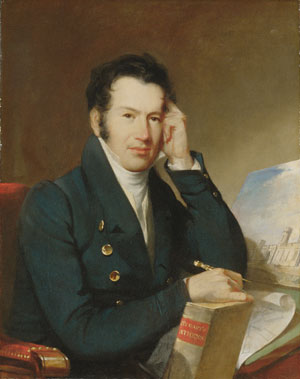John Haviland
1792-1852

John Haviland by John Neagle (1828)
Haviland was born in Somerset England and bound to an architect in 1811. He left the firm in hope of securing an appointment to the Russian Imperial Corps of Engineers. In Russia, he met John Quincy Adams who encouraged him to come to the United States — which he did in 1816. Haviland was one of the few professional architects in the city in the early 19th century, maintaining an office at 26 N. 5th Street.
He wrote a book called The Builder's Assistant, containing the five orders of architecture "for the use of builders, carpenter, mason, plasterers, cabinet makers, and carvers..." which appeared in 3 volumes. The book was phenomenally important for being one of the earliest pattern books in the United States. It was probably the first to include both Greek and Roman orders.
Haviland later reissued Carpenters' Company member and Arch Street Friend's Meeting House designer Owen Biddle's "Young Carpenter's Assistant" with a new preface and several additional plates. Haviland then went on to open a drawing academy with Hugh Bridgport and later taught drawing at the Franklin Institute (today the Atwater Kent Museum) which he designed.
Haviland was forced into bankruptcy in the 1830s which curtailed his building in Philadelphia. Haviland today is mainly remembered as an architect of prisons, having designed the New Jersey Penitentiary in 1833-36; the "Tombs" in New York City in 1835-38; and prisons in Missouri, Rhode Island, and Arkansas. Philadelphia's Eastern State Penitentiary which housed prisoners until the 1960s is today a popular tourist attraction.
HAVILAND BUILDINGS
- Eastern State Penitentiary (1821) — 20th and Fairmount
- Saint Andrews Episcopal Church (1822) — 256 S. 8th
- Pennsylvania Institute for the Deaf and Dumb (1824) — Broad and Pine (today The University of the Arts)
- Franklin Institute (1825) — 15 S. 7th St. (today the Atwater Kent Museum)
- Old City Hall (1790-91) — 5th and Chestnut (alterations and additions)
- Walnut Street Theater (1827) — 9th and Walnut (oldest theater in the U.S.)
- The Tombs in NYC (1835-38)
BUILDINGS DEMOLISHED
- Chinese pagoda and Labyrinthine Garden (1828) — 24th and Fairmount.
- Pennsylvania Fire Insurance Company (1835) — Walnut bet. 5th and 6th (the absolutely wonderful Egyptian front wall still remains — incorporated in the modern skyscraper).


